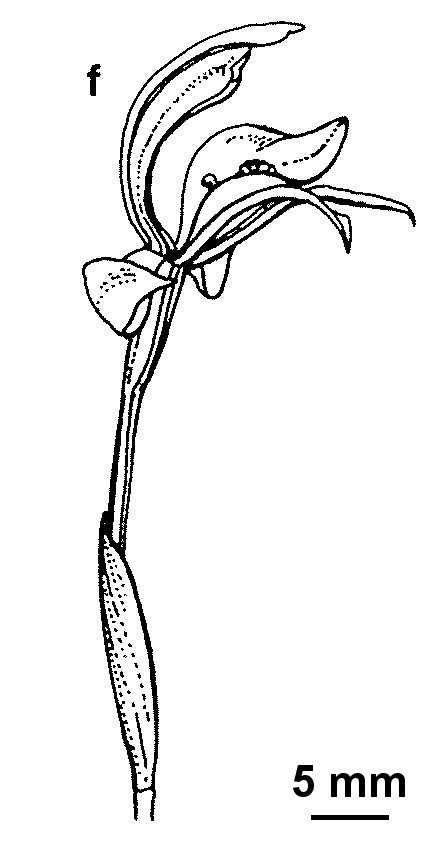Chiloglottis ×pescottiana
R.S.Rogers Bronze Bird-orchidFlowering plant 4–8 cm tall (scape elongating to 10 cm or more after pollination). Leaves elliptic to ovate, 25–60 mm long, 15–25 mm wide, dark green, margin entire. Flower greenish-bronze to purplish-brown; dorsal sepal erect, incurved, spathulate, 12–15 mm long, with apical point; lateral sepals recurved, divergent, linear-lanceolate, 12–15 mm long; petals widely spreading or incurved, linear-lanceolate, slightly asymmetric, 12–15 mm long. Labellum on short claw, mostly elliptic to ovate, 10–14 mm long, rounded at tip, margins often irregular; calli dark, almost black, stalked and sessile, in medial strip, with a bilobed or curved gland towards apical end of calli group, and a large stalked gland towards base surrounded by smaller calli, these extending towards base of lamina. Column winged in upper half, the points of the wings higher than the anther. Flowers Aug.–Nov.
VRiv, GipP, CVU, NIS, EGL, EGU, HSF, HNF, VAlp. Also NSW. Found in open forests and coastal scrubs, mostly in eastern Victoria, and highly localised and rare (e.g. Mornington Peninsula, Tallangatta, Cheshunt, Genoa).
A localized natural hybrid between Chiloglottis valida and C. trapeziformis that could occur wherever the two parent species grow together. Some populations from north-east Victoria differ from typical C. ×pescottiana in having an almost obovate labellum and petals deflexed against the ovary (making them somewhat closer to the C. trapeziformis parent), and presumably result from backcrosses.
Entwisle, T.J. (1994). Orchidaceae. In: Walsh, N.G.; Entwisle, T.J., Flora of Victoria Vol. 2, Ferns and Allied Plants, Conifers and Monocotyledons, pp. 740–901. Inkata Press, Melbourne.
 Spinning
Spinning
